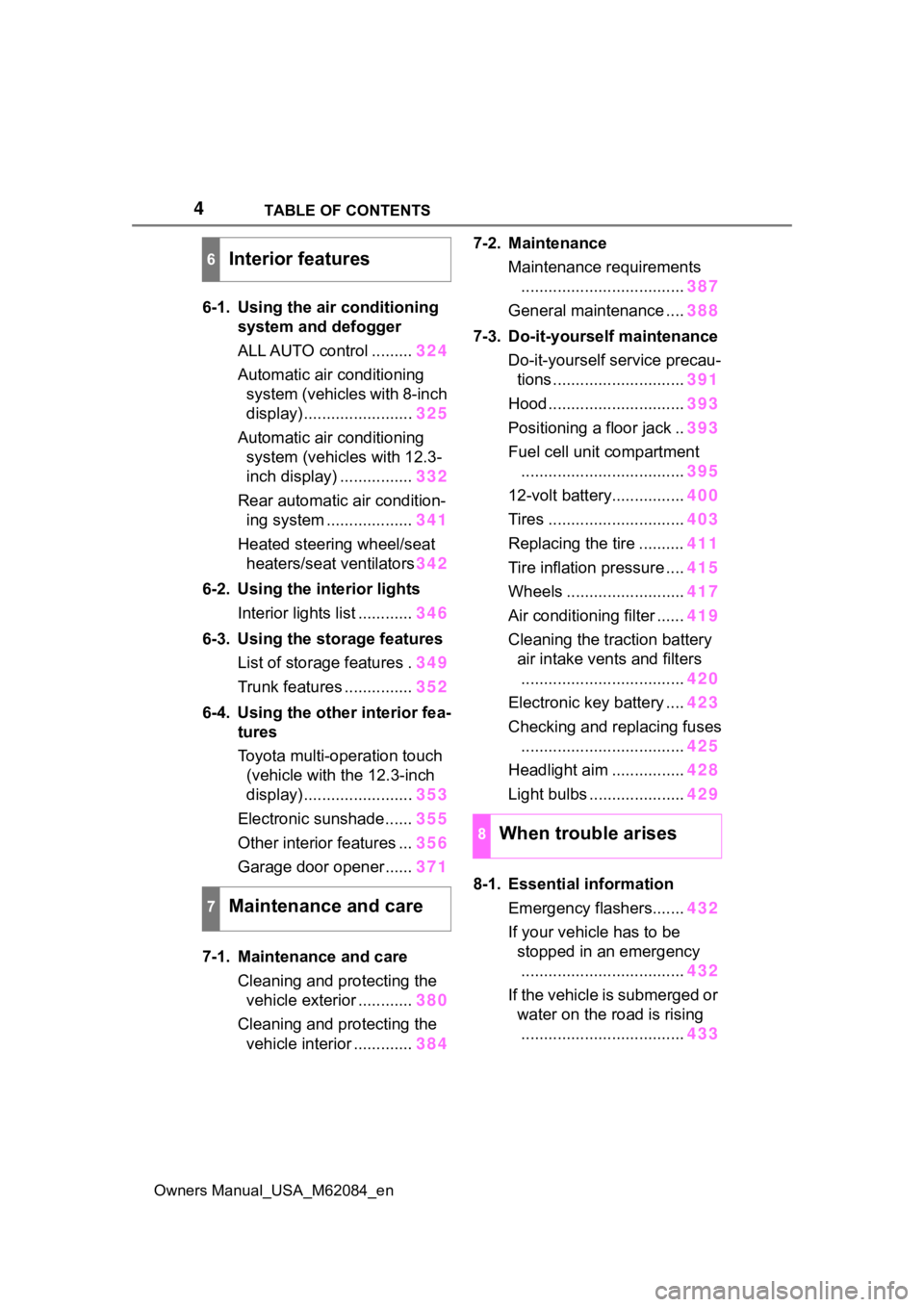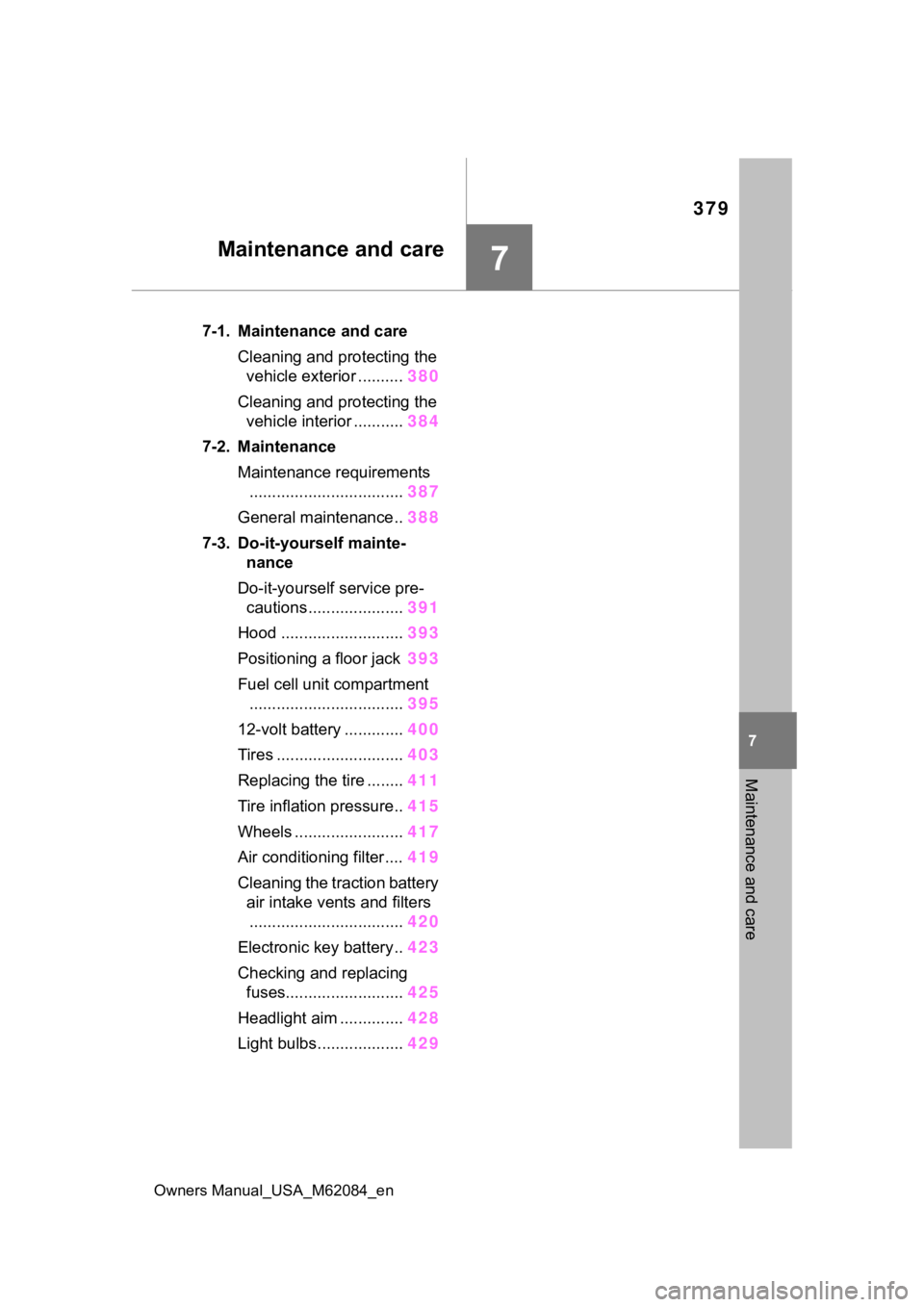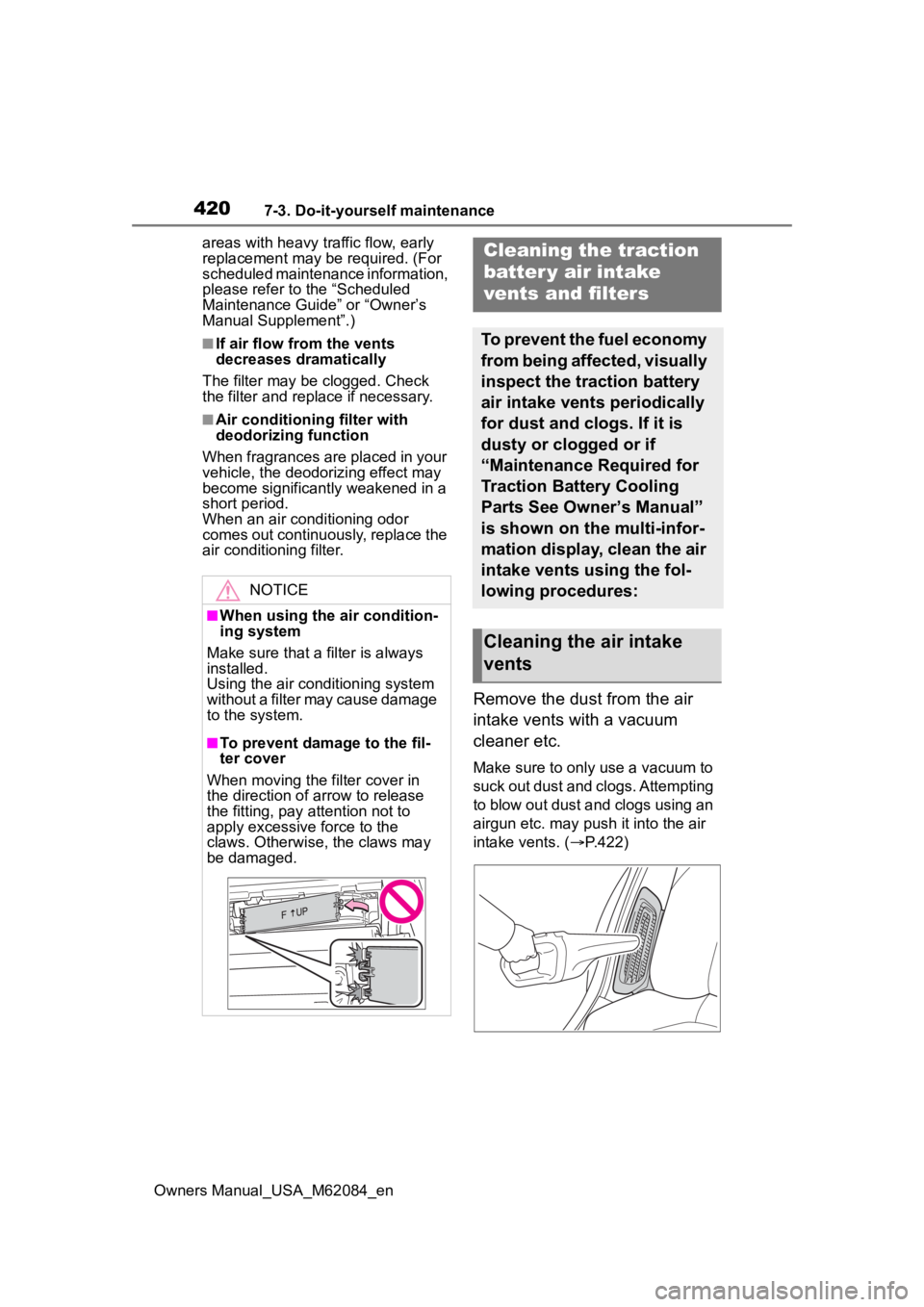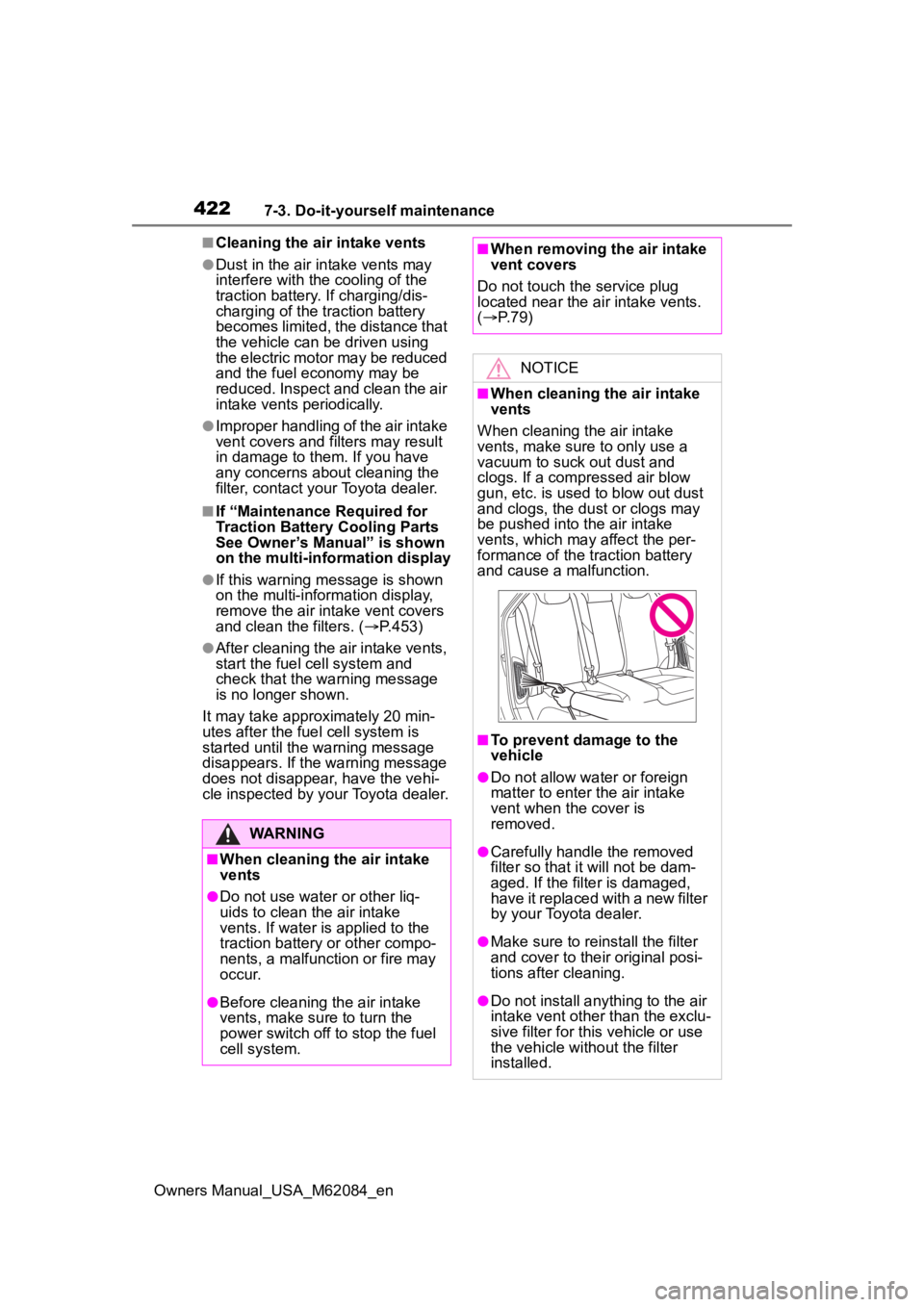2022 TOYOTA MIRAI fuel filter
[x] Cancel search: fuel filterPage 4 of 556

4TABLE OF CONTENTS
Owners Manual_USA_M62084_en
6-1. Using the air conditioning
system and defogger
ALL AUTO control ......... 324
Automatic air conditioning system (vehicles with 8-inch
display) ........................ 325
Automatic air conditioning system (vehicles with 12.3-
inch display) ................ 332
Rear automatic air condition- ing system ................... 341
Heated steering wheel/seat heaters/seat ventilators 342
6-2. Using the interior lights Interior lights list ............ 346
6-3. Using the storage features List of storage features . 349
Trunk features ............... 352
6-4. Using the other interior fea- tures
Toyota multi-operation touch
(vehicle with the 12.3-inch
display) ........................ 353
Electronic sunshade...... 355
Other interior features ... 356
Garage door opener...... 371
7-1. Maintenance and care Cleaning and protecting the vehicle exterior ............ 380
Cleaning and protecting the vehicle interior ............. 3847-2. Maintenance
Maintenance requirements.................................... 387
General maintenance .... 388
7-3. Do-it-yourself maintenance Do-it-yourself service precau-tions ............................. 391
Hood .............................. 393
Positioning a floor jack .. 393
Fuel cell unit compartment .................................... 395
12-volt battery................ 400
Tires .............................. 403
Replacing the tire .......... 411
Tire inflation pressure .... 415
Wheels .......................... 417
Air conditioning filter ...... 419
Cleaning the traction battery air intake vents and filters
.................................... 420
Electronic key battery .... 423
Checking and replacing fuses .................................... 425
Headlight aim ................ 428
Light bulbs ..................... 429
8-1. Essential information Emergency flashers....... 432
If your vehicle has to be stopped in an emergency.................................... 432
If the vehicle is submerged or water on the road is rising.................................... 433
6Interior features
7Maintenance and care
8When trouble arises
Page 81 of 556

812-1. Fuel cell vehicle
Owners Manual_USA_M62084_en
2
Fuel cell system
High-voltage cables (orange)
Fuel cell stack (fuel cell and hydrogen pump)
Air compressor
Air conditioning compressor
■If “Hydrogen Leakage Detected
Visit Your Dealer” is displayed
on the multi-information display
A small amount of hydrogen gas
may be leaking. Have the vehicle
inspected immediately at the near-
est Toyota dealer.
■If “FCV System Shutdown Due
to Hydrogen Leakage Stop in a
Safe Place See Owner’s Man-
ual” is displayed on the multi-
information display
●Hydrogen gas may be leaking.
When hydrogen gas is leaking or
some other malfunction is
detected: P. 8 5
●The air conditioning system will
shut off automatically.
■Running out of fuel
When the vehicle has run out of fuel
and the fuel cell system cannot be
started, refuel the vehicle until the
low fuel level warning light ( P.447)
turns off before try ing to restart. It
may not be able to restart if the refu-
eled amount is too low.
■Fuel cell stack
●Depending on the usage environ-
ment, the fuel ce ll power output
may decline over the life of the
vehicle. However, this will have
almost no effect on driving perfor-
mance.
●In the following situations, the fuel
cell power output may decline
faster than normal driving:
• Extended use in areas with high amounts of dust
• Extended use in areas with high levels of sulfur (such as volcanoes
or hot springs). • Extended use in areas with high
concentrations o f the following
substances:
-Organic solvents, such as paint and
thinner
-Amine-related materials such as
ammonia
-Chlorinated substances such as
salt air and snow-melting agent
• Salt water gets into the air cleaner filter
It is recommended to replace the
air cleaner filter and clean the sur-
rounding components. Have the
vehicle inspected at your Toyota
dealer
• The number of times the fuel cell system is started and stopped is
excessively high
• Extended use in freezing tem- peratures
• Fill fuel with impurities which do not follow ISO-14687
■Hydrogen tanks
●The hydrogen tanks are the high-
pressure storage containers that
are filled with co mpressed hydro-
gen gas. The vehicle can be refu-
eled at hydrogen stations.
●The hydrogen tanks have an expi-
ration date. Vehicles with expired
hydrogen tanks must not be
driven or refueled until the hydro-
gen tanks are replaced. The expi-
ration date is written on the inside
of the fuel door. Consult your Toy-
ota dealer.
●Consult your Toyota dealer if the
hydrogen tanks or valves need to
be disposed.
Page 82 of 556

822-1. Fuel cell vehicle
Owners Manual_USA_M62084_en
■Fuel cell stack coolant
●Fuel cell stack coolant uses a spe-
cifically-designed fluid with high
electrical insulation properties, in
order to safely cool the high-volt-
age fuel cell stack.
●Never add water or other coolants
to the fuel cell stack cooling sys-
tem, as they will cause permanent
damage.
●Consult your Toyota dealer for
replenishing or changing the fuel
cell stack coolant.
■Ion filter
●An ion filter is inst alled in the cool-
ant lines for the fuel cell stack, in
order to maintain the normal insu-
lation properties of the coolant.
●It is necessary to periodically
change the ion filter. ( P.454)
Contact your Toyota dealer for this
periodic maintenance.
■Tailpipe
●When the power switch is turned
off and the fuel cell system is
stopped ( P.174) after driving,
exhaust water is discharged. Be
careful when standing behind the
vehicle to avoid dripping or spray-
ing.
●It is possible to manually purge
the exhaust. Thi s may be desir-
able, for instance, before parking
in a garage. This is done by press-
ing the H
2O switch. ( P.189)
●On cold days, water vapor in the
exhaust may appe ar as a white
mist emitted from the tailpipe. This
is not a malfunction. A white mist
may be emitted from the vehicle
side depending on the wind direc-
tion. If it is a concern, consult with
a Toyota dealer.
●If the tailpipe is blocked, the fuel
cell system will stop.
●In the following state when cold, a
white mist may be emitted. Water
vapor is being emitted as a sys-
tem protection and it is not a mal- function.
• If several minutes have passed after opening the fuel lid, such as
refueling.
• Several hours have passed after the power switch was turned off.
■Hydrogen detectors
When the power switch is turned to
ON, the hydrogen detectors are
activated.
■Power output restriction
When the power output is restricted,
the vehicle may fa il to accelerate or
even decelerate, even though the
accelerator pedal is depressed. If a
safe driving speed cannot be main-
tained, stop the ve hicle in a safe
place away from the traffic. This
may be caused by the following con-
ditions:
●The coolant temperature may be
too high. This can be caused by
driving conditions such as
repeated sudden acceleration and
deceleration, continuous driving
on an incline, continuous driving
at high altitudes with a high load,
etc. In such situations, “FCV sys-
tem overheated Output power
reduced” is displayed on the multi-
information display, and the power
output is restricted. Once the cool-
ant returns to normal temperature,
the power output will retu rn to nor-
mal. ( P.452)
●The remaining fuel may be low.
After the low fuel level warning
light comes on, the output power
will be gradually restricted in order
to extend the possible driving dis-
tance. Once getting to this point,
the remaining driving distance
possible is short. Immediately refill
the vehicle with hydrogen.
●On cold days, the low fuel level
warning light comes on faster than
usual and the output power is
restricted.
■Electromagnetic waves (EMF)
●High-voltage parts and cables in
Page 88 of 556

882-1. Fuel cell vehicle
Owners Manual_USA_M62084_en
■If a warning light comes on, a
warning message is displayed,
or the 12-volt battery connec-
tion is disconnected
The fuel cell system may not be
able to restart.
If the “READY” indicator does not
come on, even when the start pro-
cedure is repeated, contact your
Toyota dealer.
There are air intake vents on
each side of the rear seatback
with the purpose of cooling the
traction battery. If the vents
become blocked, traction bat-
tery output may be reduced.
Traction battery air intake
vents
NOTICE
■Traction battery air intake
vents
●Make sure not to block the air
intake vents with anything, such
as a seat cover, plastic cover, or
luggage. If the vents become
blocked, the traction battery
input and output may be
restricted, leading to a reduction
in traction batte ry output and a
malfunction.
●Periodically clean the air intake
vents with a vacuum cleaner to
prevent clogging from accumu-
lated dust, etc.
●A filter is installed to the air
intake vent. When the filter
remains noticeably dirty even
after cleaning the air intake
vent, filter cleaning or replace-
ment is recommended. When
cleaning or replacing the filter,
contact your Toyota dealer.
Refer to P.420 for details on
how to clean the filters.
●Do not get water or foreign
materials in the air intake vents
as this may cause a short circuit
and damage the traction bat-
tery.
Page 379 of 556

379
Owners Manual_USA_M62084_en
7
7
Maintenance and care
Maintenance and care
7-1. Maintenance and careCleaning and protecting the vehicle exterior .......... 380
Cleaning and protecting the vehicle interior ........... 384
7-2. Maintenance Maintenance requirements.................................. 387
General maintenance.. 388
7-3. Do-it-yourself mainte- nance
Do-it-yourself service pre- cautions ..................... 391
Hood ........................... 393
Positioning a floor jack 393
Fuel cell unit compartment .................................. 395
12-volt battery ............. 400
Tires ............................ 403
Replacing the tire ........ 411
Tire inflation pressure.. 415
Wheels ......... ...............417
Air conditioning filter .... 419
Cleaning the traction battery air intake vents and filters.................................. 420
Electronic key battery.. 423
Checking and replacing fuses.......................... 425
Headlight aim .............. 428
Light bulbs................... 429
Page 392 of 556

3927-3. Do-it-yourself maintenance
Owners Manual_USA_M62084_en
Tire inflation
pressure
( P.415)• Tire pressure
gauge
• Compressed air source
Washer fluid
( P.399)
• Water or washer
fluid containing
antifreeze (for
winter use)
• Funnel (used only for adding
water or washer
fluid)
WARNING
The fuel cell unit compartment
contains many mechanisms and
fluids that may move suddenly,
become hot, or become electri-
cally energized. To avoid death or
serious injury, observe the follow-
ing precautions.
■When working on the fuel cell
unit compartment
●Be careful not to touch the high-
voltage parts or hydrogen-
related parts.
●Make sure that the “READY”
indicator is off.
●Keep hands, clothing and tools
away from the moving fan.
●Be careful not to touch the
motor, inverter, radiator, etc.
right after driving as they may
be hot. Coolant and other fluids
may also be hot.
●Do not leave anything that may
burn easily, such as paper and
rags, in the fuel cell unit com-
partment.
ItemsParts and tools●Do not smoke, cause sparks or
expose an open flame to the 12-
volt battery. 12-volt battery
fumes are flammable.
●Be extremely cautious when
working on the 12-volt battery. It
contains poisonous and corro-
sive sulfuric acid.
●Take care because brake fluid
can harm your hands or eyes
and damage painted surfaces. If
fluid gets on your hands or in
your eyes, flush the affected
area with clean water immedi-
ately.
If you still experience discom-
fort, consult a doctor.
●Never touch, disassemble,
remove or replace the high-volt-
age parts, cables and their con-
nectors. It can cause severe
burns or electric shock that may
result in death or serious injury.
■When working near the elec-
tric cooling fan or radiator
grille
Be sure the power switch is off.
With the power switch in ON, the
electric cooling fa n may automati-
cally start to run if the air condi-
tioning is on and/or the coolant
temperature is high. ( P.398)
■Safety glasses
Wear safety glasses to prevent
flying or falling material, fluid
spray, etc. from getting in your
eyes.
NOTICE
■If you remove the air cleaner
filter
Driving with the air cleaner filter
removed may cause excessive
motor wear due to dirt in the air.
Page 420 of 556

4207-3. Do-it-yourself maintenance
Owners Manual_USA_M62084_enareas with heavy traffic flow, early
replacement may be required. (For
scheduled maintenance information,
please refer to the “Scheduled
Maintenance Guide” or “Owner’s
Manual Supplement”.)
■If air flow from the vents
decreases dramatically
The filter may be clogged. Check
the filter and replace if necessary.
■Air conditioning filter with
deodorizing function
When fragrances are placed in your
vehicle, the deodorizing effect may
become significantly weakened in a
short period.
When an air conditioning odor
comes out continuously, replace the
air conditioning filter.
Remove the dust from the air
intake vents with a vacuum
cleaner etc.
Make sure to only use a vacuum to
suck out dust and clogs. Attempting
to blow out dust and clogs using an
airgun etc. may push it into the air
intake vents. ( P.422)
NOTICE
■When using the air condition-
ing system
Make sure that a filter is always
installed.
Using the air conditioning system
without a filter may cause damage
to the system.
■To prevent damage to the fil-
ter cover
When moving the filter cover in
the direction of arrow to release
the fitting, pay attention not to
apply excessive force to the
claws. Otherwise, the claws may
be damaged.
Cleaning the traction
batter y air intake
vents and filters
To prevent the fuel economy
from being affected, visually
inspect the traction battery
air intake vents periodically
for dust and clogs. If it is
dusty or clogged or if
“Maintenance Required for
Traction Battery Cooling
Parts See Owner’s Manual”
is shown on the multi-infor-
mation display, clean the air
intake vents using the fol-
lowing procedures:
Cleaning the air intake
vents
Page 422 of 556

4227-3. Do-it-yourself maintenance
Owners Manual_USA_M62084_en
■Cleaning the air intake vents
●Dust in the air intake vents may
interfere with the cooling of the
traction battery. If charging/dis-
charging of the traction battery
becomes limited, the distance that
the vehicle can be driven using
the electric motor may be reduced
and the fuel economy may be
reduced. Inspect and clean the air
intake vents periodically.
●Improper handling of the air intake
vent covers and filters may result
in damage to the m. If you have
any concerns about cleaning the
filter, contact you r Toyota dealer.
■If “Maintenance Required for
Traction Battery Cooling Parts
See Owner’s Manual” is shown
on the multi-information display
●If this warning message is shown
on the multi-information display,
remove the air inta ke vent covers
and clean the filters. ( P.453)
●After cleaning the air intake vents,
start the fuel cell system and
check that the warning message
is no longer shown.
It may take approximately 20 min-
utes after the fuel cell system is
started until the warning message
disappears. If the warning message
does not disappear, have the vehi-
cle inspected by your Toyota dealer.
WARNING
■When cleaning the air intake
vents
●Do not use water or other liq-
uids to clean the air intake
vents. If water is applied to the
traction battery or other compo-
nents, a malfunction or fire may
occur.
●Before cleaning the air intake
vents, make su re to turn the
power switch off to stop the fuel
cell system.
■When removing the air intake
vent covers
Do not touch the service plug
located near the air intake vents.
( P. 7 9 )
NOTICE
■When cleaning the air intake
vents
When cleaning the air intake
vents, make sure to only use a
vacuum to suck out dust and
clogs. If a comp ressed air blow
gun, etc. is used to blow out dust
and clogs, the dust or clogs may
be pushed into the air intake
vents, which may affect the per-
formance of the traction battery
and cause a malfunction.
■To prevent damage to the
vehicle
●Do not allow wa ter or foreign
matter to enter the air intake
vent when the cover is
removed.
●Carefully handle the removed
filter so that i t will not be dam-
aged. If the filter is damaged,
have it replaced with a new filter
by your Toyota dealer.
●Make sure to reinstall the filter
and cover to their original posi-
tions after cleaning.
●Do not install anything to the air
intake vent other than the exclu-
sive filter for this vehicle or use
the vehicle witho ut the filter
installed.